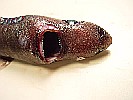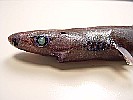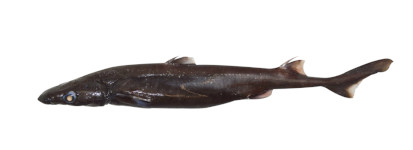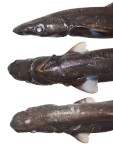Etmopterus bigelowi
Shirai & Tachikawa, 1993
Blurred smooth lantern shark
Classification: Elasmobranchii Squaliformes Etmopteridae
Reference of the original description
Taxonomic resolution of the Etmopterus pusillus species group (Elasmobranchii, Etmopteridae), with description of E. bigelowi, n. sp. Copeia, 1993(2), 483–495
Taxonomic resolution of the Etmopterus pusillus species group (Elasmobranchii, Etmopteridae), with description of E. bigelowi, n. sp. Copeia, 1993(2), 483–495
Image of the original description
Image in copyright.
Image in copyright.
Types
Etmopterus bigelowi
Holotype: HUMZ: 100176; Paratype: AMS: I.22809-034; CAS: 48786; CAS: 56056; FAKU: 46064; FSFL: EM 873; FSFL: EM 564; FSFL: EM 565; FSFL: EM 566; FSFL: S 427; FUMT: P 10508; FUMT: P 10506; FUMT: P 10504; FUMT: P 10094; FUMT: P 10507; FUMT: P 10505; FUMT: P 10503; GCRL: 15729; HUMZ: 100180; HUMZ: 100042; HUMZ: 100175; HUMZ: 100177; HUMZ: 100028; HUMZ: 74378; HUMZ: 68734; HUMZ: 100178; HUMZ: 100025; HUMZ: 100179; MCZ: 40677; MCZ: 39758; MCZ: 39757; MCZ: 39744; MCZ: 39743; MCZ: 39572; NSMT: P 40022; SIO: 85-171; USNM: 220332; USNM: 220331; USNM: 157835;
Etmopterus bigelowi
Holotype: HUMZ: 100176; Paratype: AMS: I.22809-034; CAS: 48786; CAS: 56056; FAKU: 46064; FSFL: EM 873; FSFL: EM 564; FSFL: EM 565; FSFL: EM 566; FSFL: S 427; FUMT: P 10508; FUMT: P 10506; FUMT: P 10504; FUMT: P 10094; FUMT: P 10507; FUMT: P 10505; FUMT: P 10503; GCRL: 15729; HUMZ: 100180; HUMZ: 100042; HUMZ: 100175; HUMZ: 100177; HUMZ: 100028; HUMZ: 74378; HUMZ: 68734; HUMZ: 100178; HUMZ: 100025; HUMZ: 100179; MCZ: 40677; MCZ: 39758; MCZ: 39757; MCZ: 39744; MCZ: 39743; MCZ: 39572; NSMT: P 40022; SIO: 85-171; USNM: 220332; USNM: 220331; USNM: 157835;
Description :
Citation: Etmopterus bigelowi Shirai & Tachikawa, 1993: In: Database of modern sharks, rays and chimaeras, www.shark-references.com, World Wide Web electronic publication, Version 01/2026
Please send your images of "Etmopterus bigelowi" to info@shark-references.com

Etmopterus bigelowi Shirai & Tachikawa, 1993 (NCIP 6568), female, 675 mm TL, fish landing at Tanjungluar, east Lombok, Indonesia © Fahmi, Research Center for Oceanography, Jakarta, Indonesia

Etmopterus bigelowi Shirai & Tachikawa, 1993 (NCIP 6568), female, 675 mm TL, fish landing at Tanjungluar, east Lombok, Indonesia © Fahmi, Research Center for Oceanography, Jakarta, Indonesia
Common names
 Blurred lantern shark,
Blurred lantern shark,  Blurred smooth lantern shark,
Blurred smooth lantern shark,  Smooth lanternshark
Smooth lanternshark
 Blurred lantern shark,
Blurred lantern shark,  Blurred smooth lantern shark,
Blurred smooth lantern shark,  Smooth lanternshark
Smooth lanternshark
Short Description
Original diagnosis of SHIRAI & TACHIKAWA, 1993 [3668]: Etmopterus sharing diagnostic characters (1)- (3) with E. pusillus. Other features are (4) black flank mark similar to that of E. pusillus, but less distinct; (5) 16-19 turns in the spiral valve; (6) first dorsal fin relatively anterior in position, distance from pectoral axil to first dorsal fin three or more times in interdorsal space; (7) first dorsal spine long and stout, equal to or longer than first dorsal-fin base; (8) upper jaw teeth with a relatively stout and thick central cusp, teeth numbering 19-24; (9) lower teeth with an inclined to semioblique cusp, becoming erect just before maturation; and (10) 49-57 mono-spondylous vertebrae, 60-70 precaudal verte-brae, and 82-93 total vertebrae.
Original diagnosis of SHIRAI & TACHIKAWA, 1993 [3668]: Etmopterus sharing diagnostic characters (1)- (3) with E. pusillus. Other features are (4) black flank mark similar to that of E. pusillus, but less distinct; (5) 16-19 turns in the spiral valve; (6) first dorsal fin relatively anterior in position, distance from pectoral axil to first dorsal fin three or more times in interdorsal space; (7) first dorsal spine long and stout, equal to or longer than first dorsal-fin base; (8) upper jaw teeth with a relatively stout and thick central cusp, teeth numbering 19-24; (9) lower teeth with an inclined to semioblique cusp, becoming erect just before maturation; and (10) 49-57 mono-spondylous vertebrae, 60-70 precaudal verte-brae, and 82-93 total vertebrae.
Distribution
Atlantic, Indian Ocean and Western Pacific. In the western Atlantic from the Gulf of Mexico to Argentina [19579].
First record: 2017: Flores Sea, eastern Indonesia, Two specimens of E. bigelowi, both mature females measuring 675 (NCIP 6568) and 659 (NCIP 6567) mm TL (Fig. 1), were collected from the fish landing at Tanjungluar, east Lombok, Indonesia (8.778o S; 116.516o E) on November 25, 2016 [25797] Source: www.gbif.org
Atlantic, Indian Ocean and Western Pacific. In the western Atlantic from the Gulf of Mexico to Argentina [19579].
First record: 2017: Flores Sea, eastern Indonesia, Two specimens of E. bigelowi, both mature females measuring 675 (NCIP 6568) and 659 (NCIP 6567) mm TL (Fig. 1), were collected from the fish landing at Tanjungluar, east Lombok, Indonesia (8.778o S; 116.516o E) on November 25, 2016 [25797] Source: www.gbif.org
Biology
Distinct pairing with embrace [17086]. Found on the continental shelf and slope (Ref. 75154). Feeds on small sharks, squids and myctophids.
Distinct pairing with embrace [17086]. Found on the continental shelf and slope (Ref. 75154). Feeds on small sharks, squids and myctophids.
Dentition
Upper and lower jaw teeth strongly dissimilar; 22 (19-24) teeth on upper jaw and 36 (25-39) on lower jaw margins. Each upper tooth with broad, bifid root, and relatively broad, subtriangular, erect, sharp-pointed central cusp, and several pairs of minute to relatively longer lateral cusps; one or two tooth series functional. Each lower tooth with broad rectangular base and single, smooth-edge, bladelike cusp; cusps oblique to semiob-lique; each tooth overlapping neighboring tooth to form a continuous serrate cutting edge along jaw; single series functional. Etmopterus bigelowi shows profound morpho-metry changes with growth, which arc very similar to those of E. pusillus; in both sexes, the trunk length increases allometrically (from approximately 18-32% TL). The change in the growth rate of trunk length also occurs, but it is found in slightly larger specimens of both sexes (more than 40 cm TL). An increase in number of lateral cusps on the upper jaw teeth occurs as in E. pusillus but is confined to large males (more than 45 cm TL). Cusps of lower jaw teeth gradually become erect and tips point upward. Such a transformation is observed in males over 35 cm TL and in females over 43 cm TL. Jaw dentition: Morphology and number of jaw teeth do not clearly differentiate Etmopterus bigelowi from E. pusillus but are good clues to identify them. In similar-sized specimens, the upper jaw teeth of E. bigelowi are relatively larger with a broad central cusp than those of E. pusillus. Etmopterus bigelowi has relatively fewer teeth than E. pusillus regardless of geographic region or body size, 19-24 vs 22-31 in upper and 25-39 vs 30-53 in lower. An increase of lateral cusps of male upper jaw teeth is found in specimens larger than 45 cm TL in E. bigelowi and 38 cm TL in E. pusillus. The gradual erection of lower jaw tooth cusps occurs with maturation in E. bigelowi, but the cusps remain strongly oblique at all sizes in E. pusillus [3668];
Upper and lower jaw teeth strongly dissimilar; 22 (19-24) teeth on upper jaw and 36 (25-39) on lower jaw margins. Each upper tooth with broad, bifid root, and relatively broad, subtriangular, erect, sharp-pointed central cusp, and several pairs of minute to relatively longer lateral cusps; one or two tooth series functional. Each lower tooth with broad rectangular base and single, smooth-edge, bladelike cusp; cusps oblique to semiob-lique; each tooth overlapping neighboring tooth to form a continuous serrate cutting edge along jaw; single series functional. Etmopterus bigelowi shows profound morpho-metry changes with growth, which arc very similar to those of E. pusillus; in both sexes, the trunk length increases allometrically (from approximately 18-32% TL). The change in the growth rate of trunk length also occurs, but it is found in slightly larger specimens of both sexes (more than 40 cm TL). An increase in number of lateral cusps on the upper jaw teeth occurs as in E. pusillus but is confined to large males (more than 45 cm TL). Cusps of lower jaw teeth gradually become erect and tips point upward. Such a transformation is observed in males over 35 cm TL and in females over 43 cm TL. Jaw dentition: Morphology and number of jaw teeth do not clearly differentiate Etmopterus bigelowi from E. pusillus but are good clues to identify them. In similar-sized specimens, the upper jaw teeth of E. bigelowi are relatively larger with a broad central cusp than those of E. pusillus. Etmopterus bigelowi has relatively fewer teeth than E. pusillus regardless of geographic region or body size, 19-24 vs 22-31 in upper and 25-39 vs 30-53 in lower. An increase of lateral cusps of male upper jaw teeth is found in specimens larger than 45 cm TL in E. bigelowi and 38 cm TL in E. pusillus. The gradual erection of lower jaw tooth cusps occurs with maturation in E. bigelowi, but the cusps remain strongly oblique at all sizes in E. pusillus [3668];
Remarks
shark-references Species-ID=2157;
shark-references Species-ID=2157;










_(MNHN_2005-2707_BPS-0452).jpg)











